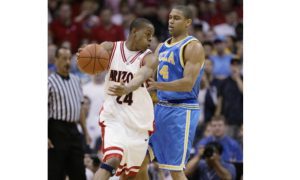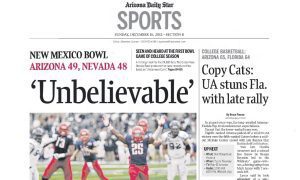|
|
|
ARIZONA PRODUCTIVITY RATING
[table “” not found /]
GLOSSARY:
G: Games played. S: Number of starts.
BP: Bench points. A player gets three points if he is first off the bench, two if second and one if third. Shows Sean Miller’s rotation.
WSU: Productivity points against Washington State
WMIN: Minutes played against Washington State
PP: Productivity Points (Points, assists, rebounds, steals, blocked shots, FGs made, FTs made added together and then subtracted by missed FGs, missed FTs, personal fouls and turnovers)
TMIN: Minutes played overall
PR: Productivity rating per minute played (Productivity points divided by minutes played)
NOTE: Player must average at least 10 minutes a game to be listed in primary rotation
The last time was is in 2002-03 when the Wildcats won their last 10 games to finish 17-1. The 17-1 teams in 1988-89 and 1989-90 also ran the table in the second half. None of Arizona’s four Final Four teams managed the feat.

Solomon Hill gets ready to release a shot that banks in from three-quarters of the court before halftime at Washington State on Saturday (ESPN video, click on picture to access video)
If Arizona plays the way it has in the second part of their weekly conference slate, the Wildcats will go 9-0 in the second half in flying colors. They are anti-UCLA when it comes to producing better in the second game of the week. The Bruins historically under Ben Howland have fallen flat on Saturday after winning on Thursday.
This year is no different for Howland. In conference play, the Bruins are 4-0 on Thursdays and 2-2 on Saturdays, including losses in each of the past two Saturday games (one of which was an embarrassing 78-60 loss at ASU after beating Arizona 84-73 in McKale Center). They are averaging 73.5 points and shooting 45 percent on Thursdays, and averaging 68.25 points and shooting 43.1 percent on Saturdays.
The Wildcats are 2-2 on Thursdays and 4-0 on Saturdays when they play two opponents in a week. After Saturday night’s win at Washington State, the Wildcats have outscored their second-game foes by a combined 51 points, an average margin of victory of 12.8 points.
It is more difficult for a coach to prepare a team with one game in between Thursday and Saturday games than having three or four days to practice for the Thursday game. Sean Miller’s work in preparing the Wildcats and getting them to refocus this season is impressive, although he would be the first to say they must produce better on Thursday games.
Arizona seniors Solomon Hill and Mark Lyons especially stepped up against Washington State after having dismal performances in a 57-53 victory at Washington on Thursday. They were emblematic of Arizona going from a 35.1 percent shooting performance from the field compared to 47.4 percent against Washington State.
“To be able to move forward and get a win says a lot about our team,” Miller told the media after the win over Washington State. “It says a lot about Solomon Hill. I believe he is one of the best players in college basketball.”
Hill went from having 10 productivity points (see glossary for definition) in 36 minutes against Washington to posting 23 in 39 minutes against Washington State. Lyons had one of his unproductive games against Washington with two productivity points in 34 minutes. He had 22 productivity points in 23 minutes against the Cougars.
Nick Johnson was next with 15 productivity points in 31 minutes despite playing with flu-like symptoms. Kaleb Tarczewski capped his best Pac-12 weekend with 14 productivity points in 20 minutes. Against Washington and Washington State, Tarczewski had 29 productivity points in 49 minutes (a productivity rating of .592).
Tarczewski managed only four rebounds against the Cougars — Grant Jerrett and Brandon Ashley led the Cats with only five each — as Washington State out-rebounded the UA 32-29. It is only the fifth time Arizona has been out-rebounded this season (Charleston Southern, Florida, San Diego State and UCLA are the others to top the Cats).
Defensive Rebounding Percentage (DRB%): Determined by dividing Arizona’s defensive rebounds (22 against Washington State) by the opposition’s offensive rebounds (Washington State had eight) added to Arizona’s defensive rebounds (22) — 22/(8 + 22) = 73.3 percent.
Offensive Rebounding Percentage (ORB%): Determined by taking Arizona’s offensive rebound total (seven) divided by that total (seven) and the defensive rebounds of the opponent (24 for Washington State) — 7/(7+24) = 22.6 percent.
Ideal marks are 72 percent DRB% and 38 percent ORB%.
|
DEFENSIVE/OFFENSIVE REBOUNDING% [table “” not found /] |
Site publisher, writer and editor Javier Morales is a former Arizona Press Club award winner
[rps-paypal]
|
|






























